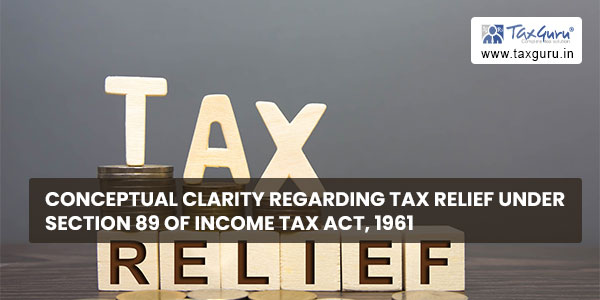First of all, we should understand the concept of – Why Tax Relief is given to Taxpayers?
Income Tax is Calculated on Assessee Taxable Income (which is arrived after summing up of Income of Five Heads – Income from Salary Head , Income from House Property , Income from Profession and Business and Income From Other Source and claiming deduction under chapter VIA).
If your current Taxable Income is increased due to arrears relating to Preceding Previous Years or Past Years received in current years that’s why your tax liability is increased. So Income Tax Act, 1961 allows a relief under section 89(1) to the assessee to claim relief, if any made.
- Tax relief can only be claimed if the tax payable is genuinely higher as a result of the receipt of such arrears. Relief is not available if there is no additional tax liability.
The Assessee should not confuse with Tax Rebate and Tax Relief. Some differences are given below to understand the difference between these two terms.
Page Contents
- Distinction between Tax Relief and Tax Rebate under Income Tax Act, 1961
- When will Relief under Section 89(1) of Income Tax Act, 1961 become available?
- Steps to Follow while calculating Tax Relief under section 89(1) :-
- Concept regarding Form 10E :-
- How to File Form 10E:
- Frequently Asked Questions regarding Form 10E:
Distinction between Tax Relief and Tax Rebate under Income Tax Act, 1961
| Basis of Difference | Tax Relief | Tax Rebate |
| Meaning | If any individual receive any portion of his salary in arrears or in advance or profits in lieu of salary 17(3), he or she can claim relief under section 89(1) of Income Tax Act, 1961. | Any Resident Individual whose taxable income is lower than exemption limit to entitled a rebate of Certain amount. |
| Eligible Persons | Those Person whose arrears relate to Salary, Gratuity , Premature withdrawal from Provident Fund, Family Pension and compensation on termination on employment. | Resident – Individual |
| Section Governed | Section 89(1) of Income Tax Act, 1961 | Section 87A of Income Tax Act,1961 |
| Amount | Tax Relief amount is calculated by following some Steps which is prescribed in Income Tax Act, 1961 Which are given below. | From Assessment Year – 2020-2021 onwards, The amount of Rebate is lower of followings –
(1) 100% of Total Tax Calculated Or (2) Rs. 12,500 |
| Type | Any relief of Tax , if any | Refund of Tax paid , if any |
Note (1): – Section 87A was introduced in Income Tax Act through Finance Act, 2003
Note (2): – If a person received or receivable any amount of money in respect of voluntary retirement or termination of his service, if he or she gets the benefit of exemption under section 10(10C) then he or she is not entitled to get benefit under section 89(1) of Income Tax Act, 1961.
When will Relief under Section 89(1) of Income Tax Act, 1961 become available?
- Salary received in arrear or in advance (Rule 21A(2));
- Receipt of Gratuity for Past Service (Rule 21A(3));
- Commuted Pension (Rule 21A(5));
- Compensation on termination of Employment(Rule 21A(4));
Steps to Follow while calculating Tax Relief under section 89(1) :-
Before, reading the Steps of calculating Tax Relief, Here is an example to understand these steps with conceptual clarity.
Example : Mr. A is salaried person whose salary income and other source income for Financial Year 2020-21 is Rs. 10,69,055.33 (computed) and he is also get some arrears of salary for Rs. 58,443.95 for A.Y. 2018-19 , Rs. 1,45,244.86 for A.Y. 2019-20 and Rs. 81,093.86 for A.Y. 2020-2021. Total arrears of Salary is Rs. 2,84,782,67and his taxable income of A.Y. 2018-19 IS Rs. 7,44,610 , for A.Y. 2019-20 IS Rs. 5,12,360 & for A.Y. 2020-21 IS Rs. 7,20,920. Calculate the amount of relief for A.Y. 2021-22 as per Income Tax Act,1961.

1. The assessee should calculate tax liability on total Income including arrear received in current year.
2. Then assessee should calculate tax liability on total income excluding arrear in the year in which it is received.
3. Calculate difference between Steps (1) and Steps (2).
:- For ease of calculation, a draft format of above example for theses three above steps :-
| Particulars | Including arrear of Salary | Excluding arrear of salary |
| Current Year Income (Computed) | 10,69,055.33 | 10,69,055.33 |
| Add : Arrears of Salary | 2,84,782.67 | — |
| Taxable Income | 13,53,838 | 10,69,055.33 |
| Income Tax thereon | 2,18,651.40 | 1,33,216.60 |
| Add : Health and Education cess @4% | 8,746.06 | 5,328.66 |
| Tax Payable | 2,27,397.46 | 1,38,545.26 |
4. Now, Calculate tax liability on total income of the year including arrears to which arrears are relates.
5. Calculate tax liability on total income of the year excluding arrears to which arrears are relates.
6. Calculate difference arrived in Steps (4) and Steps (5).
7. The amount of relief will be the difference between Steps (3) and Steps (6). If the amount in Steps (6) exceeds the amount in Steps (3), no relief will be granted.
:- For ease of calculation of Steps (4) to Steps (6) – Draft Format of above example is given below :-
| Computation of Tax Payable on Arrears of Salary if Charged to Tax in the Respective AYs | ||||||
| Particulars | A.Y. 2018-2019 | A.Y. 2019-2020 | A.Y. 2020-21 | |||
| Including Arrears (in Rs.) | Excluding Arrears (in Rs.) | Including Arrears (in Rs.) | Excluding Arrears (in Rs.) | Including Arrears (in Rs.) | Excluding Arrears (in Rs.) | |
| Taxable Income | 7,44,610.00 | 7,44,610.00 | 5,12,360.00 | 5,12,360.00 | 7,20,920.00 | 7,20,920.00 |
| Add: Arrears of Salary | 58,443.95 | – | 1,45,244.86 | – | 81,093.86 | – |
| Taxable Salary | 8,03,053.95 | 7,44,610.00 | 6,57,604.86 | 5,12,360.00 | 8,02,013.86 | 7,20,920.00 |
| Tax on the Above | 73,110.79 | 61,422.00 | 44,020.97 | 14,972.00 | 72,902.77 | 56,684.00 |
| Add: Cess @ 3 or 4 % | 2,193.32 | 1,842.66 | 1,760.84 | 598.88 | 2916.11 | 2267.36 |
| Tax Payable | 75,304.11 | 63,264.66 | 45,781.81 | 15,570.88 | 75,818.88 | 58,951.36 |
For ease of Calculation of Steps (7) draft Figure of Example is given below :-
| Computation of Relief under Section 89 | ||
| Particulars | Total (in Rs.) | |
| (1) Tax Payable in A.Y. 2021-22 on Arrears | ||
| Tax on Income including Arrears | 2,27,397.46 | |
| Less: Tax on income excluding arrears | 1,38,545.26 | 88,852.19 |
| (2) Tax Payable in respective Years on Arrears | ||
| Tax on income including Arrears | 1,96,904.81 | |
| Less: Tax on Income excluding Arrears | 1,37,786.90 | 59,117.91 |
| Relief under Section 89 – Differences between tax on Arrears in A.Y. 2021-22 and Tax on above in the respective Years | 29,734.29 | |
Concept regarding Form 10E :-
If you want to claim tax relief under Section 89(1) of the Income Tax Act 1961, you must fill out Form 10E. You can claim tax relief for salary received in the form of arrears under Section 89(1) of the Income Tax Act. Part B of your Form 16 reflects any arrears you’ve received.
How to File Form 10E:
Before filing Form 10E, there are some steps to be kept in mind –
1. Log in to e-filing Portal – https://eportal.incometax.gov.in/iec/foservices/#/login
2. Go to E-file Tab and then proceed for Income Tax Forms
3. Go to Tab – Person without Business/Profession and then Choose Form 10E.
4. Then select correct Assessment Year.
5. Select the submission mode and click on Continue.
6. Fill the details regarding current year income and arrears.
7. To review the details and submit the Form, click ‘Preview & Submit’.
Frequently Asked Questions regarding Form 10E:
Question 1:- What is Form 10E?
Answer: If you received arrear or advance salary for preceding previous year, then to claim relief in Income Tax. You must submit Form 10E.
Question 2:- How to submit Form 10E?
Answer: Submission of Form 10E is through online mode by log in to e-filing portal.
Question 3:- Is Form 10E mandatory to file?
Answer: Yes, it is mandatory to file Form 10E, if you want to claim Tax relief.
Question 4:- When should I file Form 10E?
Answer: Before you can file your tax return, you must first fill out Form 10E.
Question 5:- What happens if I don’t file Form 10E but claim relief under Section 89 in my ITR?
Answer: If you don’t file Form 10E but claim relief under Section 89 in your ITR, your ITR will be processed, but the relief claimed under Section 89 will be denied.
*****
Disclaimer:- The above article is only for informative purpose. It is not intended to be taken as professional advice or a formal recommendation.






1- Which amount should be filled in column 5 of form 10E , Calculated amount or the amount already paid in respective year?
2- System is not giving benefit of senior citizen while auto calculating tax for column 6 of form 10E?
3- System is auto calculating tax as per old regime in column 6 of form 10E, while I have opted new regime since FY 2020-21 ?
4- Can Standard Deduction be claimed from arrear salery in respective year while filling form 10E, when it was not claimed before due to non payment in whole year.
please help in above quarries soon.
first time i did not understand anything tax guru explained